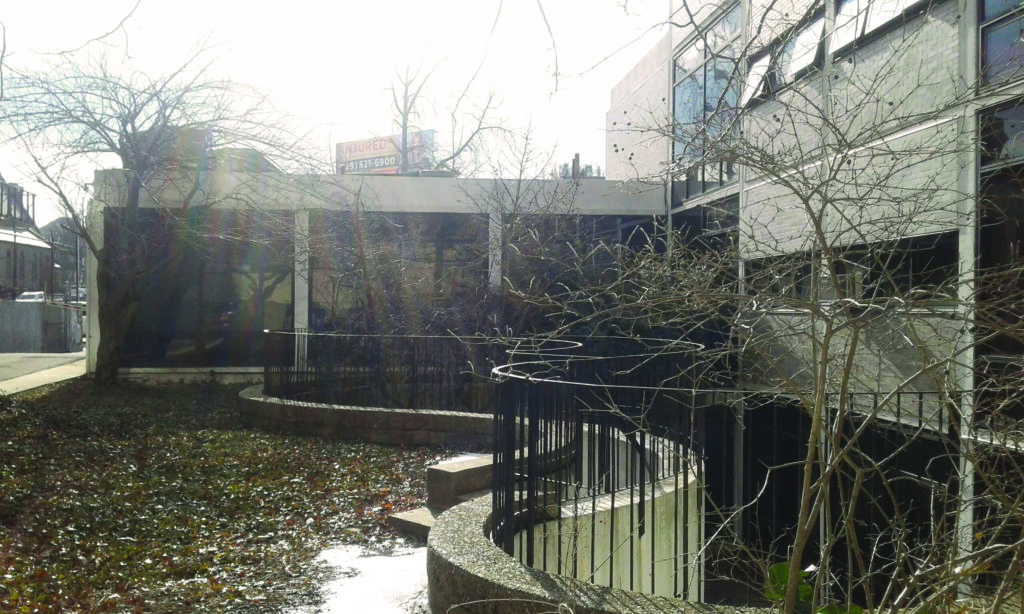Many passersby stroll past this building daily. Some may overlook it. Others may absorb its angles, edges, and almost illusion of not having much depth. The HIP center, at 86-15 Queens Blvd, built as a medical clinic in 1957, is an example of mid-century modern architecture, sadly the number of which have dwindled down in lieu of current constructions, whose aesthetics seem secondary to its finished product, that of filling space. The building property was donated to the community by philanthropic doctors, and area residents, James and Nina Rudel, immigrants who escaped Nazi occupied Europe during WW2. Pi Capital Partners purchased the clinic building in 2019 for $17 million. Soon after permits were filed in April 2022, the clinic was closed, offices were cleared out, and patients were advised to register with other area medical centers. As of this writing, work has yet to begun on demolition, but green fencing has now surrounded its perimeter. Plans are for a 7 story structure, with 142 residences – 44 of those units reserved for senior housing.
For those familiar with this corner of Broadway and Queens Blvd in recent decades, Pi Capital Partners developed the two behemoths that now occupy both sides; Queens West, occupied previously by a Wendy’s (McDowell’s in Coming to America), the rotund European American Bank, also an example of mid-century modern architecture, and Queens East, where a 1940s two level art deco structure of mixed businesses stood until engulfed by a mysterious fire in the early 2000’s. 86-15, when completed, is to be called Elm South, and is to feature a similar design as the first two.
The crossroads of Middleburgh
Going much further back in time, this junction is said to be the very center where Elmhurst, then known as Middleburgh, began in 1652, where Reverend John Moore, and 52 other settlers of English descent were granted permission by the Dutch to settle. Moore then peaceably negotiated with the native population in the vicinity. In fact, the very location of 86-15 was the site of the 4th incarnation of the First Presbyterian Church of Newtown, built in 1791, heavily damaged by fire in 1928, believed to have been caused by a lightning strike. The 1788 bell from the 1791 church, forged by Gerrit Bakker in Rotterdam, Netherlands, was saved, and continues to loll boldly across Queens Boulevard in the current First Presbyterian Church, built in 1895, which was moved on greased logs to its current perch during 1924-1927, when Queens Boulevard was widened. The cemetery adjacent to 86-15 was razed in the mid 1950’s, quite unceremoniously, for the apartment building next door. Those interred were transferred to the Cemetery of the Evergreens in Brooklyn, but based on information available not all of the remains were removed at that time.
Experts agree
The mid-century modern architecture movement came on the scene from Europe with the advent of the 39-40 Flushing/Corona World’s Fair, and continued into the late 1960’s. The style features straight lines, right angles, large windows, with an emphasis on open space. The aesthetics vary from simple to
ornate; from plain to futuristic, the movement seeing a renewed interest in recent years. Examples can be found throughout Queens, and on Queens Blvd. Noted preservationist Simeon Bankoff said, “Regardless of a building’s style, it is important to judge it by its local context, visual appearance, historic importance, design excellence, and a variety of other aspects. I know there is a prejudice against mid 20th century design, which is exactly that, a prejudice. There is good modern design and bad (successful or failed), the same thing which distinguishes all other designs: attention to detail, proportionality, choice and use of materials and how it is worked within its surroundings. Lots of buildings were built in this style, creating a new context. Losing them wholesale erases the history of a place.”
Frampton Tolbert, Director of the Historic Districts Council said, “This building is a significant modern structure, among others along Queens Boulevard near the Skidmore and Owings and Merrill designed Macy’s, William Cann’s Jamaica Savings Bank, and the now demolished round bank by Evans and Delahanty that was at the intersection of Queens Boulevard and Broadway. (Where Queens West is now).” Mr. Tolbert continued, “The Queens Boulevard Medical Building, 1957, is notable for several reasons. Because it is built over a rocky foundation, a stream, and the subway, the siting had to be adjusted. The mechanical equipment (heating and cooling) was placed on the roof instead of underneath, giving its stepped back façade. There was a sunken garden (no idea if that still exists, would love to know!) that helped provide interior light to the medical spaces. The architect was Abraham Geller, a lesser known but still prominent modern architect. He studied with some of the most significant modern architects in the country. The interiors of the medical complex were done by his wife Marion Geller, who was also a member of the firm Abraham Geller and Associates, and they seem to have collaborated on other projects, which was a rarity for the mid-century. I do think that this and others like it that contribute well to the streetscape need to be considered for preservation before we lose them. Many of these examples of modern design outside Manhattan are not as well known and are likely to be lost before they are considered significant.”
LiDAR technology as preservation tool
Licensed tour guide Linda Fisher has helped to bring attention to the site, once the sale and eventual demo permits went through, and has taken steps even further in an attempt to capture the building’s significance using equipment, that of 3D LiDAR camera technology. Unfortunately, calls and emails requesting permission to enter the building while it still stands to take these photos have proved unsuccessful.
Ms. Fisher said, “I first noticed the building when I was doing research for my “Queens 101” tour, which I did in Elmhurst covering highlights of Queens history. I had gone there occasionally for medical appointments. It was always a pleasant place to go, easy to navigate and well designed. I think mid-century architecture is pivotal in shaping the character of Queens, focusing on Queens Boulevard in Elmhurst, Rego Park, and Forest Hills. While not everything can be preserved, the Landmarks Commission has overlooked many of our hidden gems; there is a new technology that is developing which would allow historic buildings to be preserved digitally.”
Ms. Fisher explained this new tool as not just as a last-ditch effort, but a powerful new tech resource which can preserve historic buildings for the future. “Historic Building Information Modeling (H-BIM) uses special cameras and software to create a ‘digital twin’ of a structure so it can be observed and examined as a 3-D model, complete with all the exterior and interior elements. The model can be accessed with a Virtual Reality or Augmented Reality device, allowing an immersive ‘walk through’ as though the physical building still existed. Less detailed modeling can be done in an inexpensive way, using a LiDAR camera, which can be found on an iPhone13, but more detailed imaging can be done using sophisticated equipment used by architectural firms and construction companies.”
Ms. Fisher’s leap into new technology occurred when she got a virtual reality (VR) headset and began to explore many places in which this tech was being applied, some true physical spaces, others imaginative.
Some create 3D models from actual photographs, a field Ms. Fisher defines as photogrammetry. Her main focus at the time was the NY State Pavilion and other World’s Fair sites, and she has communicated with a professor at the University of Central Florida, Lori Walters, who is leading this new field of modeling and simulation, and has created laser scans of several historic structures. Unfortunately, due to a ticking clock, and lack of receptiveness between developers and community, chances are slim to utilize these technologies, unless opportunities are granted for this purpose through greater understanding and transparency.
“Given that we are losing so many unprotected buildings to developers, I fear we will lose whatever opportunity we have to even preserve their memory. With great interest growing in the Metaverse every day, surely there is room for these structures to live on and not be forgotten, to one day be rediscovered by our descendants in the digital world,” concluded Ms. Fisher.




